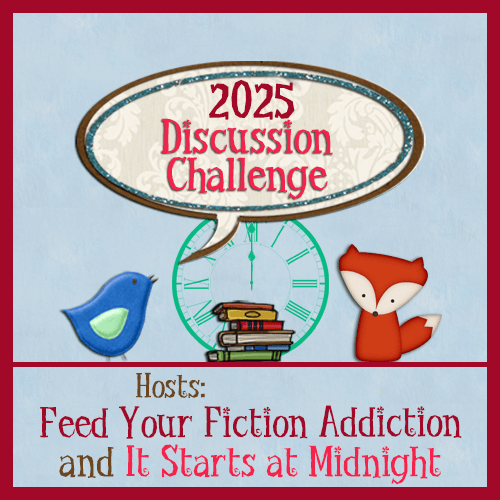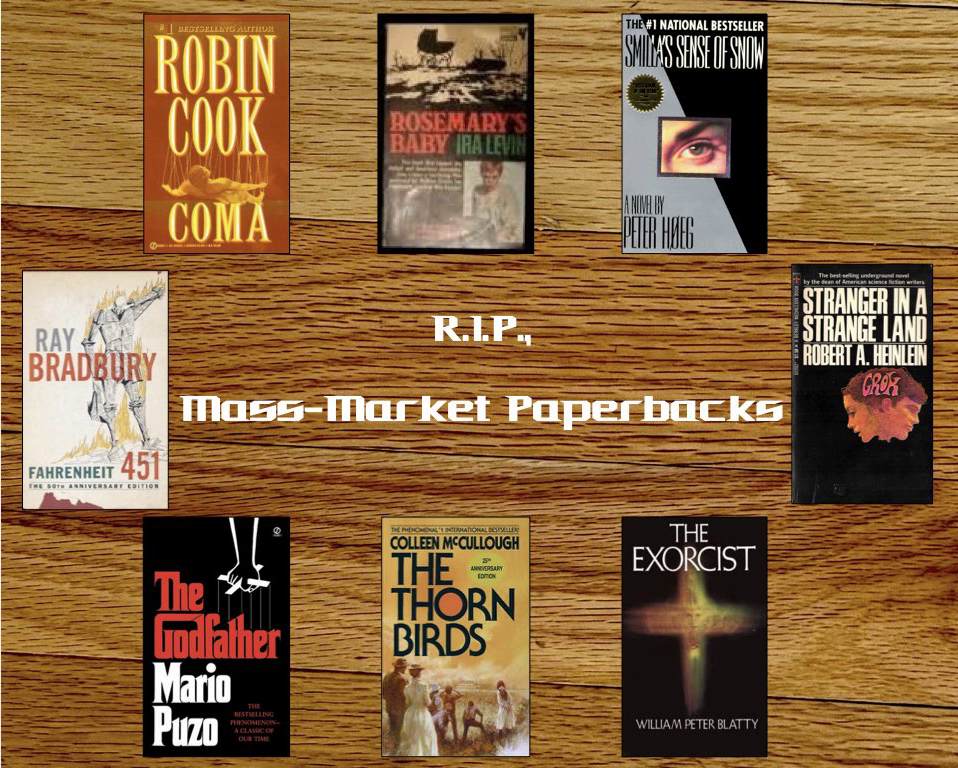Thanks to these two bloggers for sponsoring the annual Blog Discussion Challenge:
- Nicole at Feed Your Fiction Addiction
- Shannon at It Starts at Midnight

Discussion
- Rosemary’s Baby by Ira Levin
- The Exorcist by William Peter Blatty
- The Thorn Birds by Colleen McCullough
- The Godfather by Mario Puzo
- The Lord of the Rings by J.R.R. Tolkien (in 3 fat volumes)
- Stranger in a Strange Land by Robert A. Heinlein
- Fahrenheit 451 by Ray Bradbury
- Coma by Robin Cook
- Smilla’s Sense of Snow by Peter Høeg
These are some of the many books I remember carrying around and reading in mass-market paperback format. Since my late adolescence and early adulthood (my late teens, 20s, and 30s) coincided with the height of the mass market age, I felt a twinge of nostalgia when I read that mass-market paperbacks will no longer be made after 2025.
These little gems (approximately 4 inches X 6¾ inches, or 10 cm X 17 cm) were originally created to fit into a pocket; in fact, one of the earliest companies to specialize in these editions was called Pocket Books. They became plentiful during World War II, when the U.S. government contracted to send copies of books such as The Grapes of Wrath by John Steinbeck and The Great Gatsby by F. Scott Fitzgerald overseas with soldiers as a small reminder of home.
Some of the earliest books issued as mass-market paperbacks were literary classics. I read The Ambassadors by Henry James in college, and Bleak House and A Tale of Two Cities by Charles Dickens in graduate school, all in those easy-to-carry mass-market editions.
One feature of the books that made them so comfortably portable was their thin paper. The pages were translucent, with text on the other side often showing through. In addition, the page count was kept as low as possible by the use of a tiny font size.
Along with their size, the low price of these paperbacks was another feature that added to their popularity. Their existence also changed the way the public accessed books. Previously, books, almost all of which had hard covers and heavy paper pages, were sold only in bookstores. But the small paperback editions could easily be displayed in news stalls, train stations, airports, drugstores, grocery stores, and discount department stores (such as Walmart and Target).
In addition to the classics, romance and suspense—and romantic suspense—were other big categories for mass-market publication. Long before I read about Meggie’s life in The Thorn Birds by Colleen McCullough, published in 1977, I had read about the lives of countless other women in mass-market versions of books by Victoria Holt, Mary Stewart, and Phyllis A. Whitney. After I left grad school I made my first foray into science fiction with paperback works by authors including Ray Bradbury, Robert Heinlein, and Isaac Asimov. Mysteries, action/adventure stories, horror, and Westerns were other genres that mass-market publishing thrived on.
My last mass-market paperback purchase was John Scalzi’s 2005 science fiction novel Old Man’s War. I picked it up a couple of years ago to read on a long airplane flight. The tiny print is now harder on my aging eyes than it used to be, but I still appreciate how easy such a small book is to hold and read, especially in a cramped airline seat. I’m going to miss these little companions.
How About You?
What mass-market paperbacks do you have fond memories of reading?
Reference Notes
Literary agent Richard Curtis
Readerlink Will Stop Distributing Mass Market Paperbacks at the End of 2025
How Books Designed for Soldiers’ Pockets Changed Publishing Forever
How Paperbacks Transformed the Way Americans Read
The Different Types of Book Formats Explained
Paperback Talk
Books Go to War: World War II Armed Services Editions
Mass Market Paperbacks
Mass-Market Paperback History
The Book: A Cover-to-Cover Exploration of the Most Powerful Object of Our Time by Keith Houston
(Link is to Goodreads.)
When Books Went to War: The Stories that Helped Us Win World War II by Molly Guptill Manning
(Link is to Goodreads.)
Big Fiction: How Conglomeration Changed the Publishing Industry and American Literature by Dan Sinykin
(Link is to Goodreads.)
© 2025 by Mary Daniels Brown


As a kid and teen, I read a ton of paperbacks. The first that came to mind were the Choose Your Own Adventure books. I loved those and believe they were mass market paperbacks.
The Choose Your Own Adventure books were after my time, but I seem to remember that they were aimed at adolescents. In that case they probably would have been mass market, since those books were the most inexpensive and kids don’t have a lot of money. Thanks for reading and commenting, Samantha.
I just finished one: GO TELL IT ON THE MOUNTAIN by Baldwin. I fought with the physical book throughout the whole reading experience. The book was poorly constructed and the print was centered on the page, so the binding side was too close to the center. I had to use my hand muscles to hold the book open enough so I could actually read the text. It was a negative experience. Ha!
I feel your pain, Anne! Although I remember those books of my youth fondly, I admit I now have almost no patience for their shortcomings: the incredibly small print, the flimsiness of the pages, and the tendency, as you describe, for no margins, often forcing the text to emerge from the spine (on the left) and flow almost off the page (on the right). Thanks for reading and commenting.